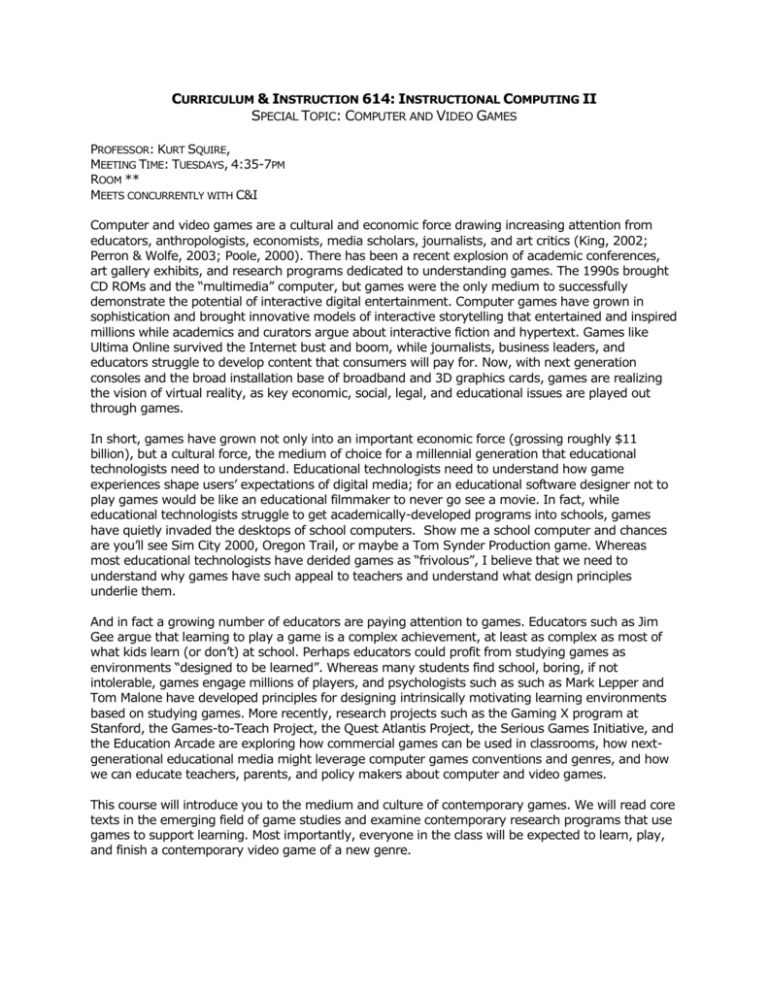CURRICULUM & INSTRUCTION 614: INSTRUCTIONAL
advertisement

CURRICULUM & INSTRUCTION 614: INSTRUCTIONAL COMPUTING II SPECIAL TOPIC: COMPUTER AND VIDEO GAMES PROFESSOR: KURT SQUIRE, MEETING TIME: TUESDAYS, 4:35-7PM ROOM ** MEETS CONCURRENTLY WITH C&I Computer and video games are a cultural and economic force drawing increasing attention from educators, anthropologists, economists, media scholars, journalists, and art critics (King, 2002; Perron & Wolfe, 2003; Poole, 2000). There has been a recent explosion of academic conferences, art gallery exhibits, and research programs dedicated to understanding games. The 1990s brought CD ROMs and the “multimedia” computer, but games were the only medium to successfully demonstrate the potential of interactive digital entertainment. Computer games have grown in sophistication and brought innovative models of interactive storytelling that entertained and inspired millions while academics and curators argue about interactive fiction and hypertext. Games like Ultima Online survived the Internet bust and boom, while journalists, business leaders, and educators struggle to develop content that consumers will pay for. Now, with next generation consoles and the broad installation base of broadband and 3D graphics cards, games are realizing the vision of virtual reality, as key economic, social, legal, and educational issues are played out through games. In short, games have grown not only into an important economic force (grossing roughly $11 billion), but a cultural force, the medium of choice for a millennial generation that educational technologists need to understand. Educational technologists need to understand how game experiences shape users’ expectations of digital media; for an educational software designer not to play games would be like an educational filmmaker to never go see a movie. In fact, while educational technologists struggle to get academically-developed programs into schools, games have quietly invaded the desktops of school computers. Show me a school computer and chances are you’ll see Sim City 2000, Oregon Trail, or maybe a Tom Synder Production game. Whereas most educational technologists have derided games as “frivolous”, I believe that we need to understand why games have such appeal to teachers and understand what design principles underlie them. And in fact a growing number of educators are paying attention to games. Educators such as Jim Gee argue that learning to play a game is a complex achievement, at least as complex as most of what kids learn (or don’t) at school. Perhaps educators could profit from studying games as environments “designed to be learned”. Whereas many students find school, boring, if not intolerable, games engage millions of players, and psychologists such as such as Mark Lepper and Tom Malone have developed principles for designing intrinsically motivating learning environments based on studying games. More recently, research projects such as the Gaming X program at Stanford, the Games-to-Teach Project, the Quest Atlantis Project, the Serious Games Initiative, and the Education Arcade are exploring how commercial games can be used in classrooms, how nextgenerational educational media might leverage computer games conventions and genres, and how we can educate teachers, parents, and policy makers about computer and video games. This course will introduce you to the medium and culture of contemporary games. We will read core texts in the emerging field of game studies and examine contemporary research programs that use games to support learning. Most importantly, everyone in the class will be expected to learn, play, and finish a contemporary video game of a new genre. Design of Educational Games Holland, W., Jenkins, H. & Squire, K. Theory by Design (2003). In Perron, B., and Wolf, M. (Eds). Video Game Theory. Routledge. Jenkins, H. Squire, K. & Tan, P. (in press). You Can’t Bring That Game To School!: Designing Supercharged! To appear in B. Laurel (Ed.) Design Research. Cambridge, MIT Press. *Squire, K. and the Games-to-Teach Research Team. (2003). Design Principles of NextGeneration Gaming for Education. Educational Technology, 43 (5). Contemporary Game Technologies Sawyer, B. (2002). The Next Ages of Game Development. Retrieved from: http://www.avault.com/developer/getarticle.asp?name=bsawyer1 Games and training Rejeski, D. (2002). Gaming out way to a better future. Retrieved from: http://www.avault.com/developer/getarticle.asp?name=drejeski1 Thiagarajan, S. 1998. The myths and realities of simulations in performance technology. Educational Technology, 38(5), 35-41. Education and Games Squire, K. (2003). Video games in education. International Journal of Intelligent Simulations and Gaming (2) 1. Squire, K.D. (2002) Rethinking the role of games in Education. Game Studies, 2(1). (http://gamestudies.org) *Squire, K. & Jenkins, H. (in press). Harnessing the Power of Games in Education. To appear in Insight. Online Games Bartle, R. (1996). Hearts, Clubs, Diamonds, Spades: Players who suit MUDs. Journal of MUD Research, 1(1). Available: http://www.mud.co.uk/richard/hcds.htm (19 May 1996). Prensky, M. (2000). Military and Gaming Chapter. *Simpson, Z. (2000). The in-game economics of Ultima Online. Paper presented at at The Computer Game Developer's Conference, March 2000, San Jose, CA Squire, K. D. & Steinkuehler, C. A. (in press). The genesis of 'CyberCulture': The case of Star Wars Galaxies. In Cyberlines: Languages and cultures of the Internet (2nd ed.). Albert Park, Australia: James Nicholas Publishers. Games in Classrooms *Jenkins, H., Klopfer, E., Squire, K. & Tan, P. (2003). Entering the education arcade. Computers in Entertainment 1(1). *McFarlane, A. & Kirriemuir, J. (2003). Use of Computer and Video Games in the Classroom, presented at DiGRA conference, Holland, November 2003. Engagement / Motivation *Bowman, R.F. 1982. A Pac-Man theory of motivation. Tactical implications for classroom instruction. Educational Technology 22(9), 14-17. Cordova, D. I., & Lepper, M. R. 1996. Intrinsic motivation and the process of learning: Beneficial effects of contextualization, personalization, and choice. Journal of Educational Psychology, 88, 715-730. Malone, T. W. 1981. Toward a theory of intrinsically motivating instruction. Cognitive Science, (4), 333-369. Games and Context Mitchell, E. 1985. The dynamics of family interaction around home video games. Special Issue: Personal computers and the family. Marriage and Family Review 8(1-2), 121-135. Gender and Games Cassel, J. & Jenkins, H. 1998b. Chess for girls? Feminism and computer games. In Cassell, J & Jenkins, H. (Ed.), From Barbie to Mortal Kombat : Gender and Computer Games. Cambridge, MA: MIT Press. Subrahmanyam K. & Greenfield, P.M. 1998. Computer games for girls: What makes them play? In Cassell, J. & Jenkins, (Ed.), From Barbie to Mortal Combat: Gender and Computer Games. Cambridge, MA: MIT Press







